Related Research Articles

Lokapāla, Sanskrit, Pāli, and Tibetan for "guardian of the world", has different uses depending on whether it is found in a Hindu or Buddhist context. In Hinduism, lokapāla refers to the Guardians of the Directions associated with the eight, nine and ten cardinal directions. In Buddhism, lokapāla refers to the Four Heavenly Kings, and to other protector spirits, whereas the Guardians of the Directions are referred to as dikpāla.
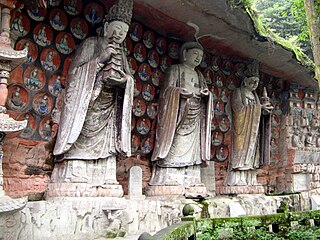
The Huayan school of Buddhism is a Mahayana Buddhist tradition that developed in China during the Tang dynasty (618-907). The Huayan worldview is based primarily on the Buddhāvataṃsaka Sūtra as well as on the works of Huayan patriarchs, like Zhiyan (602–668), Fazang (643–712), Chengguan (738–839), Zongmi (780–841) and Li Tongxuan (635–730).

Dajian Huineng, also commonly known as the Sixth Patriarch or Sixth Ancestor of Chan, is a semi-legendary but central figure in the early history of Chinese Chan Buddhism. According to tradition he was an uneducated layman who suddenly attained awakening upon hearing the Diamond Sutra. Despite his lack of formal training, he demonstrated his understanding to the fifth patriarch, Daman Hongren, who then supposedly chose Huineng as his true successor instead of his publicly known selection of Yuquan Shenxiu.
The Platform Sutra of the Sixth Patriarch is a Chan Buddhist scripture that was composed in China during the 8th to 13th century. The "platform" (施法壇) refers to the podium on which a Buddhist teacher speaks. Its key themes are the direct perception of one's true nature, and the unity in essence of śīla (conduct), dhyāna (meditation) and prajñā (wisdom).
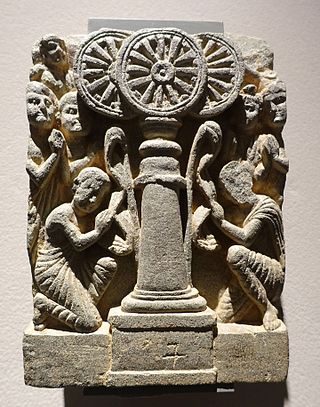
In Buddhism, refuge or taking refuge refers to a religious practice, which often includes a prayer or recitation performed at the beginning of the day or of a practice session. Since the period of Early Buddhism all Theravada and mainstream Mahayana schools only take refuge in the Three Jewels, which are the Buddha, the Dharma and the Sangha.
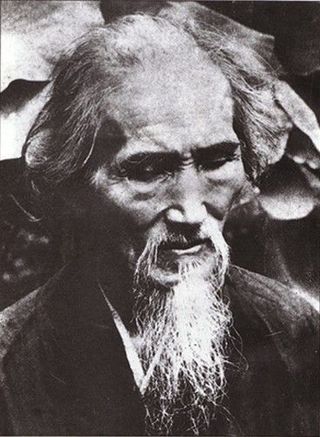
Xuyun or Hsu Yun was a renowned Chinese Chan Buddhist master and an influential Buddhist teacher of the 19th and 20th centuries.
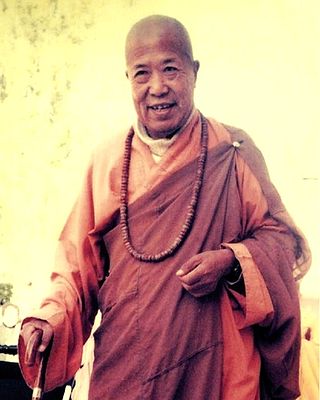
Hsuan Hua, also known as An Tzu, Tu Lun and Master Hua by his Western disciples, was a Chinese monk of Chan Buddhism and a contributing figure in bringing Chinese Buddhism to the United States in the late 20th century.

The City of Ten Thousand Buddhas is an international Buddhist community and monastery founded by Hsuan Hua, an important figure in Western Buddhism. It is one of the first Chan Buddhist temples in the United States, and one of the largest Buddhist communities in the Western Hemisphere.

The Śūraṅgama Sūtra is a Mahayana Buddhist sutra that has been especially influential on Korean Buddhism and Chinese Buddhism. It was particularly important for Zen/Chan Buddhism. The doctrinal outlook of the Śūraṅgama Sūtra is that of Buddha-nature, Yogacara thought, and esoteric Buddhism.

Dazu Huike is considered the Second Patriarch of Chan Buddhism and the twenty-ninth since Gautama Buddha. He was the successor to Bodhidharma.
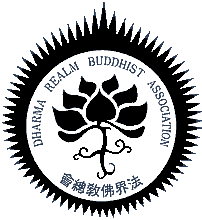
The Dharma Realm Buddhist Association is an international, non-profit Buddhist organization founded by the Venerable Master Hsuan Hua in 1959 to bring the orthodox teachings of the Buddha to the entire world. DRBA has branch monasteries in many countries and cities, including San Francisco, Los Angeles, Seattle, and Vancouver, as well as in Malaysia, Taiwan, Hong Kong, and Australia.

Ratnasambhava is one of the Five Dhyani Buddhas of Mahayana and Vajrayana or Tantric Buddhism. Ratnasambhava's mandalas and mantras focus on developing equanimity and equality and, in Vajrayana Buddhist thought is associated with the attempt to destroy greed and pride. His consort is Mamaki and his mount is a horse or a pair of lions.

Heng Sure is an American Chan Buddhist monk and a senior disciple of Venerable Hsuan Hua. He is the managing director of Berkeley Buddhist monastery and president of the board of directors of Dharma Realm Buddhist Association. Heng Sure is also a banjoist and a folk musician. He has released several albums of Buddhist folk music including "Paramita: American Buddhist Folk Songs" (2008). Heng Sure has also been active in interfaith organizations, especially the Institute for World Religions.
Vạn Hạnh Monastery is a Zen Buddhist temple in Ho Chi Minh City, the largest city in Vietnam. The temple is located at 716 Nguyễn Kiệm Street on the road between Go Vap and Phu Nhuan districts. It is the location of the main Buddhist training centre for sangha in Vietnam, and is also the office of the Vietnamese Buddhist Research Institute.

The Shurangama or Śūraṅgama mantra is a dhāraṇī or long mantra of Buddhist practice in East Asia. Although relatively unknown in modern Tibet, there are several Śūraṅgama Mantra texts in the Tibetan Buddhist canon. It has strong associations with the Chinese Chan Buddhist tradition.
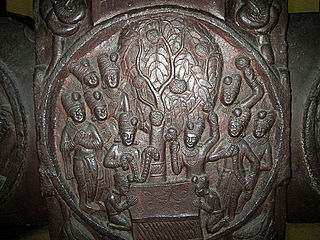
In Buddhist tradition, Vipassī (Pāli) is the twenty-second of twenty-eight Buddhas described in Chapter 27 of the Buddhavaṃsa. The Buddhavamsa is a Buddhist text which describes the life of Gautama Buddha and the twenty-seven Buddhas who preceded him. It is the fourteenth book of the Khuddaka Nikāya, which in turn is part of the Sutta Piṭaka. The Sutta Piṭaka is one of three pitakas which together constitute the Tripiṭaka, or Pāli Canon of Theravada Buddhism.

Chan, from Sanskrit dhyāna, is a Chinese school of Mahāyāna Buddhism. It developed in China from the 6th century CE onwards, becoming especially popular during the Tang and Song dynasties.
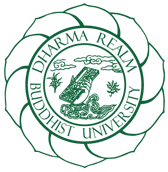
Dharma Realm Buddhist University (DRBU) is an American private nonprofit university located in Ukiah, California, just over 100 miles north of San Francisco, in Mendocino County. It was established in 1976 by Venerable Master Hsuan Hua. It is situated in the monastic setting of the City of Ten Thousand Buddhas, a Mahayana Buddhist monastery. DRBU follows a unique variation of the Great Books model, incorporating texts from both East and West. The university has a longstanding partnership with the Pacific School of Religion and the Graduate Theological Union, as well as the Dharma Realm Buddhist Association.

Ronald B. Epstein is an American scholar and translator, specializing in Mahayana Buddhism. He is also a Buddhist practitioner and community activist.
References
- ↑ Snodgrass, Judith. "Future Religion". Tricycle: The Buddhist Review. Retrieved 2020-11-05.
- 1 2 3 "Martin Verhoeven | DRBU". www.drbu.edu. Retrieved 2020-10-21.
- 1 2 chau, heng. "Heng Sure and Heng Ch'au on Bowing". Tricycle: The Buddhist Review. Retrieved 2020-10-22.
- 1 2 "Notes on People; Yale Daily News Gets Its First Female Editor in Chief". timesmachine.nytimes.com. Retrieved 2020-10-22.
- ↑ Highway Dharma Letters: Two Buddhist Pilgrims Write to Their Teacher. Buddhist Text Translation Society (BTTS). 2016. ISBN 1601030711.
- ↑ The Faces of Buddhism in America.
- ↑ "Science through Buddhist Eyes". The New Atlantis. Retrieved 2020-10-21.
- ↑ "The Sixth Patriarch's Dharma Jewel Platform Sutra". Buddhist Text Translation Society. Retrieved 2020-11-05.
- ↑ "HighwayDharmaLetters". Buddhist Text Translation Society. Retrieved 2020-11-05.